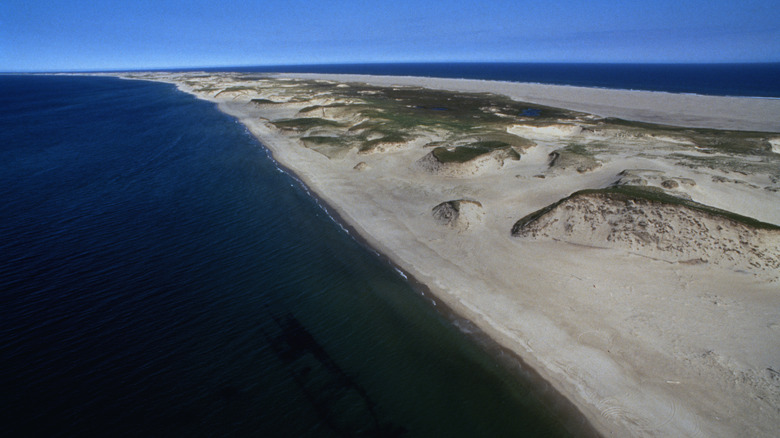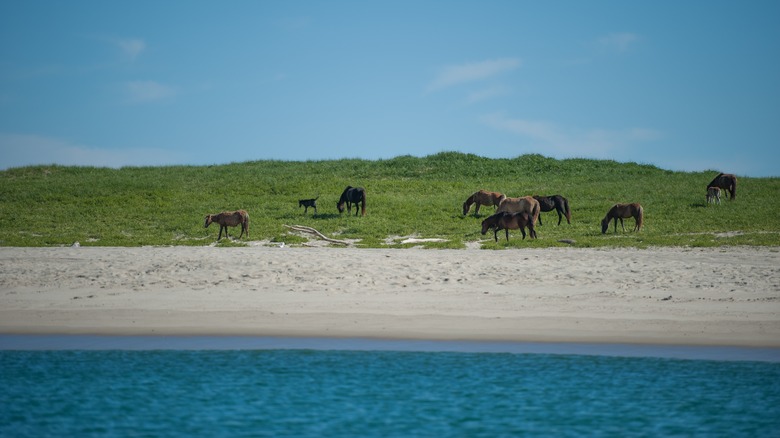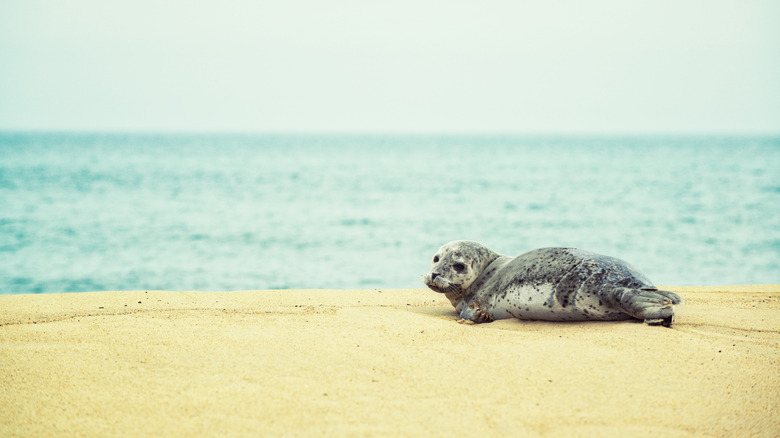One Of The Earth's Most Remote Islands Is A Strange, Secret Canadian Gem With Expansive Views
Set approximately 180 miles from Halifax, Nova Scotia, the tiny, isolated Sable Island is a 26-mile-long shifting sandbar that boasts exceptional and unique natural beauty. While it became a Canadian national park reserve in 2013, aside from tourism, it is perhaps most famous for its shipwrecks, as hundreds of vessels have met their untimely and unfortunate demises here. That's just one reason it has a reputation for being among the most dangerous islands in the world.
Getting to an island as remote as Sable is tricky and expensive. There are no facilities on the island to speak of — no town, no port, and certainly no airport. The only year-round residents are park officials, a handful of researchers, herd of hardy wild horses, and many seals. The only way to get there is by boat or aircraft, and anyone arriving by the former will have to come ashore on the beach through the surf on an inflatable boat.
Why go to the trouble of getting to Sable Island? It's an adventure within one of the last true wildernesses on the planet. Remote and stunningly beautiful, this wind-swept crescent of shifting sand is virtually untouched by humans. Unlike Canada's other beautiful island and beach destinations, nearly all trips to Sable are fully or partially guided excursions. Even if you arrive on your own boat, you must get permission to land before exploring this isolated outpost.
How to get to Sable Island
If you consider the adventure of getting to a destination to be part of the fun, Sable Island is a great choice. There are only a few ways to get to the island: On an approved tour that arrives by boat, plane, or helicopter, or by coming on a private vessel. The park allows public tours in January and February, as well as June through October, while private vessel visits are approved on a case-by-case basis.
In addition to the limited time windows for visits, the weather presents a major hurdle for any visit to Sable, so prepare to be flexible. The island features milder weather than mainland Nova Scotia, but it is windier and fog is common. There is only one airplane tour available, and the plane lands on the sand beach since there is no airport. If the sand is too soft or wet, it cannot land. Peak season on Sable Island is from June to October, although winter tours are sometimes also offered. June tends to be the foggiest time of year, but has the best temperatures. August is the hottest month on Sable, while September brings a greater risk of hurricanes.
Besides limited availability and weather issues, cost is a factor. While Canada boasts some beautiful and budget-friendly settings, there's no inexpensive way to get to Sable Island. Tickets on the fixed-wing airplane are about CAD 2,000, photography and artists expeditions from Halifax by helicopter are CAD 3,000 to 3,500, and adventure cruises that call on Sable begin around CAD 4,500.
What to do when you're on Sable Island
The most frequent visitors to Sable Islands are researchers, adventure travelers, nature enthusiasts, photographers, and artists — for many of them, a trip to this remote island is a bucket list item. Parks Canada rangers greet all guests for an introductory tour of the island, including dos and don'ts and tips on where to go and what to look out for. But booking a fully guided experience — like those offered by Picture Perfect Tours or Kattuk Expeditions — is a good idea since you have such a limited time on the island.
Hiking is your main way around the island. Climbing 120-foot-high Bald Dune, a 6-mile hike from the Main Station, affords unforgettable, expansive views of the North Atlantic. It's also a good way to meet Sable's most famous residents: The horses and seals. A herd of wild horses descended from a few animals introduced to Sable Island in the 1700s now numbers around 450. Sable is also the world's largest colony of grey seals, as 80% of them come here to breed during the winter, with around 100,000 pups born each year. Additionally, the island is an important breeding ground for various other species, like the Ipswich Sparrow.
Another thing to look out for on Sable is evidence of past shipwrecks. Known as the "Graveyard of the Atlantic" due to the more than 350 ships that have met unfortunate ends around the island, the island offers a chance to spot the "bones" of old ships popping up through the sand — ancient wood timbers covered by sand for centuries.


